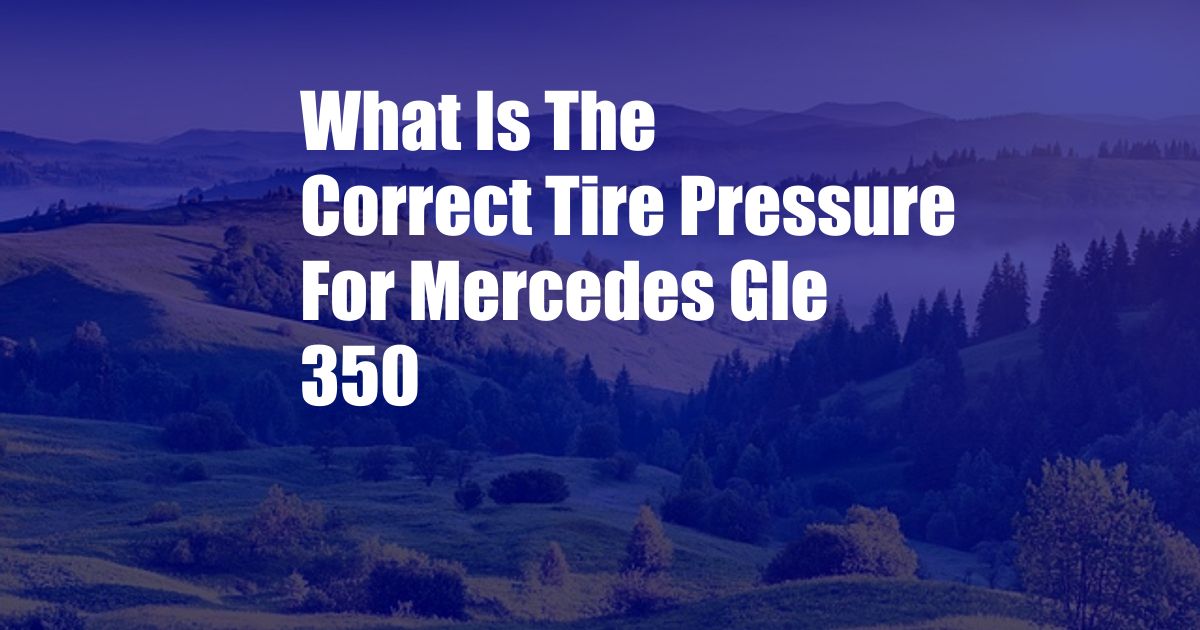
What is the Correct Tire Pressure for a Mercedes-Benz GLE 350?
Ensuring your Mercedes-Benz GLE 350 has the correct tire pressure is crucial for optimal performance, safety, and fuel efficiency. Underinflated or overinflated tires can compromise handling, increase wear and tear, and affect your vehicle’s overall performance. In this article, we’ll delve into the recommended tire pressure for the Mercedes-Benz GLE 350 and provide you with insights into its significance.
The importance of maintaining proper tire pressure cannot be overstated. Optimal tire pressure ensures:
- Enhanced Handling: Correct tire pressure provides maximum contact between the tires and the road, leading to improved stability, cornering abilities, and overall handling.
- Reduced Wear and Tear: Properly inflated tires distribute weight evenly, minimizing wear on specific areas and extending their lifespan.
- Improved Fuel Efficiency: Underinflated tires increase rolling resistance, resulting in higher fuel consumption. Maintaining the correct tire pressure minimizes resistance and enhances fuel efficiency.
- Enhanced Safety: Optimal tire pressure improves traction, reducing the risk of skidding or losing control, especially in adverse weather conditions.
Recommended Tire Pressure for Mercedes-Benz GLE 350
The recommended tire pressure for a Mercedes-Benz GLE 350 may vary depending on the specific model year and tire size. However, generally, the recommended tire pressure for the GLE 350 is:
| Tire Size | Front Tire Pressure (psi) | Rear Tire Pressure (psi) |
|---|---|---|
| 275/50R20 | 35 | 38 |
| 275/55R19 | 33 | 36 |
It’s always advisable to refer to the owner’s manual or the placard on the driver’s side door jamb for the exact recommended tire pressure for your specific vehicle.
Tips and Expert Advice
In addition to maintaining the recommended tire pressure, here are a few tips and expert advice to enhance your tire performance:
- Regular Tire Checks: Regularly check your tire pressure, especially before long trips or when the temperature fluctuates significantly.
- Use a Reliable Tire Gauge: Invest in a high-quality tire gauge to ensure accurate pressure readings.
- Consider Tire Rotation: Periodically rotate your tires to ensure even wear and extend their lifespan.
- Check for Leaks: If you notice a significant drop in tire pressure, inspect your tires for any punctures or leaks and have them repaired promptly.
- Adjust for Load and Weather: Adjust your tire pressure slightly when carrying heavy loads or driving in extreme weather conditions.
By following these tips, you can optimize the performance of your Mercedes-Benz GLE 350’s tires and enhance your overall driving experience.
Frequently Asked Questions (FAQs)
Q: What are the consequences of underinflating my tires?
A: Underinflated tires can lead to increased wear on the outer edges of the tires, poor handling, decreased fuel efficiency, and increased risk of blowouts.
Q: What are the signs of overinflated tires?
A: Overinflated tires appear rounded in the center, have reduced traction, and may lead to a bumpy ride and increased wear on the center of the tires.
Q: How often should I check my tire pressure?
A: It’s recommended to check your tire pressure at least once a month and before any long trips or significant temperature changes.
Q: Can I use the same tire pressure for all four tires?
A: No, the recommended tire pressure for the front and rear tires may differ. Refer to your owner’s manual or the placard on the driver’s side door jamb.
Q: What should I do if I have a flat tire?
A: If you have a flat tire, pull over to a safe location and change the flat tire with the spare tire. If you’re unsure how to change a tire, contact roadside assistance.
Conclusion
Maintaining the correct tire pressure for your Mercedes-Benz GLE 350 is essential for optimal performance, safety, and fuel efficiency. By following the recommended tire pressure guidelines, implementing tips and expert advice, and regularly checking your tire pressure, you can maximize the longevity of your tires and enhance your driving experience. Remember that proper tire maintenance is not just a matter of convenience but also a crucial element of responsible vehicle ownership.
Are you interested in more articles like this one? Let us know in the comments below, and we’ll be happy to provide more valuable content tailored to your interests.